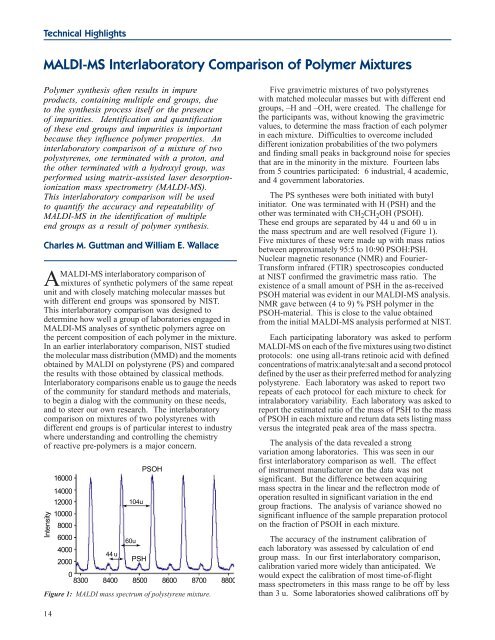Materials Science and Engineering Laboratory FY 2004 ... - NIST
Materials Science and Engineering Laboratory FY 2004 ... - NIST
Materials Science and Engineering Laboratory FY 2004 ... - NIST
Create successful ePaper yourself
Turn your PDF publications into a flip-book with our unique Google optimized e-Paper software.
Technical Highlights<br />
MALDI-MS Interlaboratory Comparison of Polymer Mixtures<br />
Polymer synthesis often results in impure<br />
products, containing multiple end groups, due<br />
to the synthesis process itself or the presence<br />
of impurities. Identification <strong>and</strong> quantification<br />
of these end groups <strong>and</strong> impurities is important<br />
because they influence polymer properties. An<br />
interlaboratory comparison of a mixture of two<br />
polystyrenes, one terminated with a proton, <strong>and</strong><br />
the other terminated with a hydroxyl group, was<br />
performed using matrix-assisted laser desorptionionization<br />
mass spectrometry (MALDI-MS).<br />
This interlaboratory comparison will be used<br />
to quantify the accuracy <strong>and</strong> repeatability of<br />
MALDI-MS in the identification of multiple<br />
end groups as a result of polymer synthesis.<br />
Charles M. Guttman <strong>and</strong> William E. Wallace<br />
AMALDI-MS interlaboratory comparison of<br />
mixtures of synthetic polymers of the same repeat<br />
unit <strong>and</strong> with closely matching molecular masses but<br />
with different end groups was sponsored by <strong>NIST</strong>.<br />
This interlaboratory comparison was designed to<br />
determine how well a group of laboratories engaged in<br />
MALDI-MS analyses of synthetic polymers agree on<br />
the percent composition of each polymer in the mixture.<br />
In an earlier interlaboratory comparison, <strong>NIST</strong> studied<br />
the molecular mass distribution (MMD) <strong>and</strong> the moments<br />
obtained by MALDI on polystyrene (PS) <strong>and</strong> compared<br />
the results with those obtained by classical methods.<br />
Interlaboratory comparisons enable us to gauge the needs<br />
of the community for st<strong>and</strong>ard methods <strong>and</strong> materials,<br />
to begin a dialog with the community on these needs,<br />
<strong>and</strong> to steer our own research. The interlaboratory<br />
comparison on mixtures of two polystyrenes with<br />
different end groups is of particular interest to industry<br />
where underst<strong>and</strong>ing <strong>and</strong> controlling the chemistry<br />
of reactive pre-polymers is a major concern.<br />
Figure 1: MALDI mass spectrum of polystyrene mixture.<br />
14<br />
Five gravimetric mixtures of two polystyrenes<br />
with matched molecular masses but with different end<br />
groups, –H <strong>and</strong> –OH, were created. The challenge for<br />
the participants was, without knowing the gravimetric<br />
values, to determine the mass fraction of each polymer<br />
in each mixture. Difficulties to overcome included<br />
different ionization probabilities of the two polymers<br />
<strong>and</strong> finding small peaks in background noise for species<br />
that are in the minority in the mixture. Fourteen labs<br />
from 5 countries participated: 6 industrial, 4 academic,<br />
<strong>and</strong> 4 government laboratories.<br />
The PS syntheses were both initiated with butyl<br />
initiator. One was terminated with H (PSH) <strong>and</strong> the<br />
other was terminated with CH2CH2OH (PSOH).<br />
These end groups are separated by 44 u <strong>and</strong> 60 u in<br />
the mass spectrum <strong>and</strong> are well resolved (Figure 1).<br />
Five mixtures of these were made up with mass ratios<br />
between approximately 95:5 to 10:90 PSOH:PSH.<br />
Nuclear magnetic resonance (NMR) <strong>and</strong> Fourier-<br />
Transform infrared (FTIR) spectroscopies conducted<br />
at <strong>NIST</strong> confirmed the gravimetric mass ratio. The<br />
existence of a small amount of PSH in the as-received<br />
PSOH material was evident in our MALDI-MS analysis.<br />
NMR gave between (4 to 9) % PSH polymer in the<br />
PSOH-material. This is close to the value obtained<br />
from the initial MALDI-MS analysis performed at <strong>NIST</strong>.<br />
Each participating laboratory was asked to perform<br />
MALDI-MS on each of the five mixtures using two distinct<br />
protocols: one using all-trans retinoic acid with defined<br />
concentrations of matrix:analyte:salt <strong>and</strong> a second protocol<br />
defined by the user as their preferred method for analyzing<br />
polystyrene. Each laboratory was asked to report two<br />
repeats of each protocol for each mixture to check for<br />
intralaboratory variability. Each laboratory was asked to<br />
report the estimated ratio of the mass of PSH to the mass<br />
of PSOH in each mixture <strong>and</strong> return data sets listing mass<br />
versus the integrated peak area of the mass spectra.<br />
The analysis of the data revealed a strong<br />
variation among laboratories. This was seen in our<br />
first interlaboratory comparison as well. The effect<br />
of instrument manufacturer on the data was not<br />
significant. But the difference between acquiring<br />
mass spectra in the linear <strong>and</strong> the reflectron mode of<br />
operation resulted in significant variation in the end<br />
group fractions. The analysis of variance showed no<br />
significant influence of the sample preparation protocol<br />
on the fraction of PSOH in each mixture.<br />
The accuracy of the instrument calibration of<br />
each laboratory was assessed by calculation of end<br />
group mass. In our first interlaboratory comparison,<br />
calibration varied more widely than anticipated. We<br />
would expect the calibration of most time-of-flight<br />
mass spectrometers in this mass range to be off by less<br />
than 3 u. Some laboratories showed calibrations off by

















